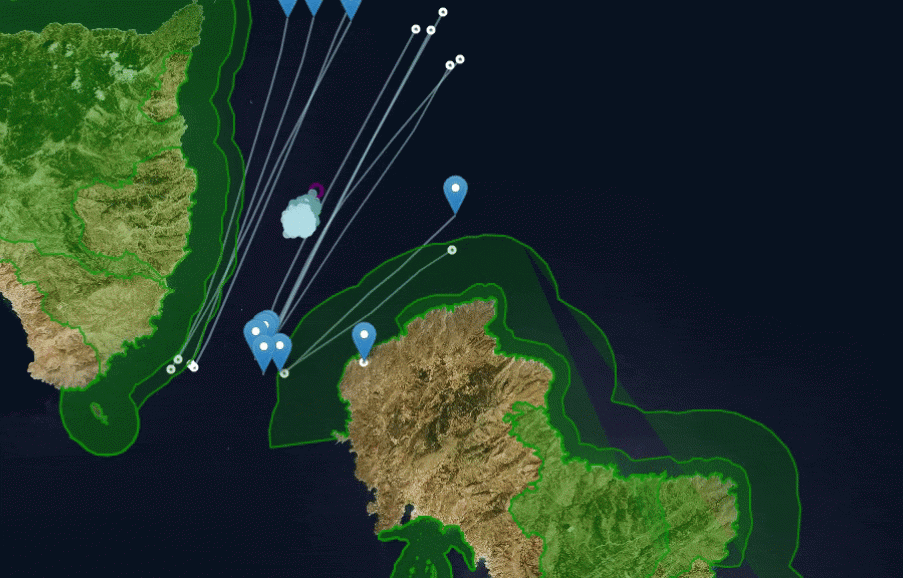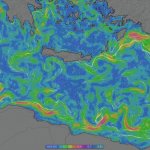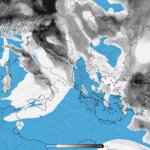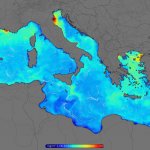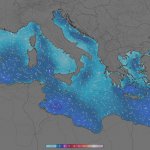Oil spill
Oil spill fate and trajectory model
Development and Implementation: HCMR
Chief Scientist: Leonidas Perivoliotis
The POSEIDON Oil Spill fate and trajectory model is based on PARCEL model (Pollani et al. 2001) which is able to simulate not only the drift of the oil but also the chemical transformations under the specific environmental conditions. The oil slick is represented as “parcels” that have time dependent chemical and physical characteristics. The 3-D position of each parcel is calculated using advection and diffusion estimates while additional information such as wind and wave conditions and hydrological characteristics are requested for the simulation of the varying physicochemical properties.
The basic oil spill fating processes simulated by the oil-spill model are the evaporation, emulsification, beaching and sedimentation.
- The evaporation process (transfer of oil from the sea surface to the atmosphere) influences mainly the lighter fractions of the hydrocarbons and can result to 20-40% loss of oil in the first few hours. It is affected by the surface area and thickness of the spill, the vapour pressure, the wind speed and the temperature. The method used to characterize the evaporation of the oil has been suggested by Stiver and MacKay (1984) and Stiver et al. (1989).
- The emulsification process describes the mixing of water in the heavier fractions of the hydrocarbons and is affected by the wind and wave conditions as well as by temperature and spill characteristics (local thickness, degree of weathering etc). The numerical approach of the emulsification process that is used in the oil spill model has been proposed by Riemsdijk van Eldik et al. (1986).
- The sedimentation process describes the trapping of oil particles that reach the sea bottom while the beaching process addresses the trapping of oil along the coast depending on the type of coastline (rocky cliff, tidal flats etc.). For beaching and sedimentation processes the model uses the Gundlach approach (1987).
The POSEIDON OSM was initially developed for the needs of the POSEIDON operational oceanography system and it was further developed and upgraded during the ROSES (2003-2004) and MarCoast (2005-2008) ESA funded projects (Perivoliotis et. al., 2006). The POSEIDON oil spill modelling system was the forecasting component of the MarCoast integrated oil spill service which provided an operational service in the Aegean Sea during 2006 and 2007, while in 2010 the model became an active element of the European Decision Support System (EuroDeSS) which was developed during the ECOOP FP6 project (Perivoliotis et. al., 2011). During the MEDESS-4MS project (2015), the POSEIDON OSM was one of three oil spill models that supported the multi-model oil spill forecasting system for the Mediterranean Sea, using environmental forcing from a variety of high resolution met-ocean forecasts that are available in daily basis from several oceanographic institutes throughout the basin (Zodiatis et.al., 2016).
During the ICT H2020 BigDataOcean (BDO) project (2017-2019), a multi-segment platform was developed, where big volume data gathered from different sources could be combined providing synthetic products to the end users, supporting the needs of the marine industry and marine science. Four targeted pilot applications were developed during the project’s lifetime, including the “Mare Protection Pilot” which was based on the POSEIDON oil spill model and the use of forecasting products from the POSEIDON system and Copernicus Marine service (CMEMS). The service is available to the user through the BDO platform https://platform.bigdataocean.eu/.
References
Gundlach E.R. (1987). “Oil holding capacities and removal coefficients for different shoreline types to compute simulate spills in coastal waters”, Proc. Oil Spill Conf., 1987, pp. 451-457.
Janjic, Z.I. (1994). “The Step-mountain Eta Coordinate Model: Further Developments of the Convection, Viscous Sublayer and Turbulence Closure Schemes”, Monthly Weather Review, 122, 927-945.
Pollani A., G.Triantafyllou, G.Petihakis , K.Nittis, K.Dounas and C.Koutitas, (2001). “The POSEIDON Operational Tool for the Prediction of Floating Pollutant Transport”, Marine Pollution Bulletin, Vol. 43/7-12, pp 270-278.
Perivoliotis L., K.Nittis, A.Charissi, (2006). “An integrated service for oil spill detection and forecasting in the marine environment”, European Operational Oceanography: Present and Future, Publication of the European Communities”, ISBN- 92-894-9788-2, pp 381-387, 2006.
Riemsdijk van Eldik J., R.J. Ogilvie, W.W.Massie (1986): “MS4: Marine spill simulation software set. Process descriptions”, Dept. Civil Engineering, Delft Univ. of Technology, Delft, The Netherlands, 74p.
Stiver W. and D. Mackay (1984), “Evaporation rate of spills of hydrocarbons and petroleum mixtures”, Envir. Sci. Technology, 18, No 11
Perivoliotis L., Krokos G., Nittis K., Korres G., (2011), “The Aegean Sea Marine Security Decision support System”, doi:10.5194/os-7-671-2011, Ocean Sci., 7, 671–683, 2011
Zodiatis, G., Dominicis,M.D., Perivoliotis,L., Radhakrishnan,H., Georgoudis,E., Sotillo, M.,Lardner,R.W., Krokos,G., Bruciaferri,D., Clementi,E., Guarnieri,A., Ribotti, A., Drago,A., Bourma,E., Padorno,E., Daniel,P., Gonzalez,G., Chazot,C., Gouriou, V., Kremer,X., Sofianos, S., Tintore,J., Garreau,P., Pinardi,N., Coppini, G., Lecci,R., Pisano,A., Sorgente,R., Fazioli,L., Soloviev,D., Stylianou,S., Nikolaidis, A., Panayidou,X., Karaolia,A., Gauci,A., Marcati,A., Caiazzo,L., Mancini, M.,(2016). “The Mediterranean decision support system for marine safety dedicated to oil slicks predictions”, Deep Sea Res. Part II: Top. Stud. Oceanogr.133, 4–20. http://dx.doi.org/10.1016/j.dsr2.2016.07.014



